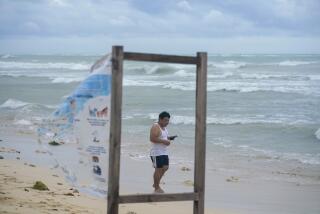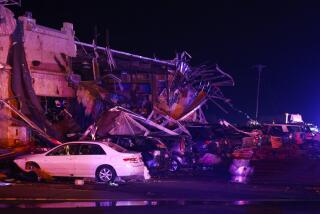In Yucatan, a 90-Mile Path of Destruction
- Share via
CANCUN, Mexico — The 90-mile drive across the path of Hurricane Gilbert from the town of Valladolid was a gantlet of trees and power lines strewn on the road. Thatched-roof homes were wrecked, crops flattened and small villages on the edge of the Yucatan jungle looked like ghost towns.
Sheets of rain slashed across the jungle-bordered road, reducing visibility to practically zero, and fierce winds blew from the north, then suddenly changed direction. Exhausted birds, unable to fly, sought refuge on the road and died.
The storm left much of Yucatan without communication, electricity or drinking water. The region was declared a disaster area Thursday afternoon and officials appealed for relief supplies.
Many areas in Yucatan remained cut off, so there were no comprehensive reports on injuries and property damage. The preliminary death toll for the region was placed at six, including two babies.
When townspeople and tourists emerged from their shelters in the popular Mexican beach resort of Cancun on Wednesday, they bore witness to the awesome destructive power of Hurricane Gilbert.
Wrecked Restaurants
As they wandered through this town of 275,000 inhabitants during an eerie lull in the storm, they stared at wrecked restaurants and businesses and picked their way across flooded streets. The roads were littered by fallen trees, signs, lampposts, scraps of tin roofing material and other debris.
Many tourists tried to return to the beachfront hotels on Cancun Island from which they had been evacuated the night before. But they and all other visitors were denied access by Mexican authorities, who set up roadblocks on the causeways linking the town of Cancun with the narrow, 13-mile-long strip of modern, high-rise hotels built on Caribbean beaches of powdery white sand.
“We’re in the eye of the hurricane,” said one Mexican official as she turned back cars and pedestrians at a roadblock. “It’s still very dangerous.”
Soon after the official spoke, the relative calm gave way to the renewed violence of the storm, the most powerful hurricane ever recorded in the Western Hemisphere.
Lashing Rains
People scurried indoors to safety, lashing rains whipped through the town and the wind began to howl. Soon Cancun’s streets were again deserted and the resort was again ruled by the storm.
It appeared, however, that the worst was over.
Mexican authorities Thursday began cleaning up the swath of destruction that Gilbert cut across the Yucatan Peninsula before heading into the Gulf of Mexico toward the Texas coast.
The 500-mile-wide storm system, packing winds of up to 170 m.p.h., wreaked havoc throughout the peninsula, which is known for its popular beach resorts and ancient Mayan ruins. The peninsula covers three states inhabited by about 2 million people.
Telecommunications with the rest of Mexico and foreign countries were cut off, piped water was stopped, airports were closed and gasoline was unavailable.
Authorities said they were particularly concerned about Isla Mujeres, a tiny resort island just off Cancun. A navy spokesman in Mexico City said he had no word on the plight of an estimated 15,000 people stranded there. Three ferries linking the island with the mainland were lost in the storm.
No Light, Radio
In Campeche, the state capital on the Yucatan Peninsula’s west coast, “there is no light, there is no radio, there is nothing,” Ramon Castillo, a night watchman at the newspaper Novedades de Campeche, told the Associated Press.
“The whole city is flooded. Everything is dark,” he said. “I’ve lived here all my life and I have never seen bad weather like this. People are scared.”
After slamming into the northeastern tip of the peninsula between Cancun and Cozumel before dawn Wednesday, the hurricane slashed across 200 miles of the largely jungle-covered territory, causing extensive damage as far away as Merida, the capital of Yucatan State. It was the first time such a phenomenon had occurred, officials said, because hurricanes normally have broken up or veered out to sea again when they have struck land here.
“Our people were not accustomed to seeing such strong winds,” said Victor Manzanilla Schaffer, the governor of neighboring Yucatan State. “We were very scared.”
Manzanilla said that at least four members of a family were killed and two others were injured when a large wall collapsed on their hut Wednesday in the coastal town of Dzidzantum. He said the hurricane had caused extensive physical damage in his state, even changing its coastline. But he said complete details on casualties and damage were still being compiled.
Wiped Out Crops
During its march across the Yucatan, the hurricane virtually wiped out the staple corn crop, toppled microwave transmission towers, flooded streets and tore the roofs off hospitals, hotels, businesses and homes.
Manzanilla said casualties were held to a minimum by the evacuation of 20,000 residents of coastal areas of Yucatan State to four inland cities. About 6,000 tourists, an estimated 90% of them American, were among the thousands of people evacuated from beachfront resort areas in Quintana Roo State, officials said.
Manzanilla said that three of the four state hospitals here were damaged and that three major warehouses in Merida collapsed. In one of them, 40,000 liters of milk--part of hurricane relief supplies--were lost, he said.
Municipal workers in Merida, a 450-year-old colonial city, started removing uprooted Indian laurel and tropical almond trees Thursday from parks and plazas, clearing debris from flooded streets and trying to restore power and telecommunications facilities.
One American tourist, Jon Blosch, a 25-year-old student at the University of Utah, said the roof of his two-story hotel blew off at the height of the storm before dawn Wednesday as he and two friends sat in their room wondering what to do.
“We ran out the door and just stayed downstairs after that,” Blosch said.
Tourists Evacuated
According to Mexican Red Cross officials, about 12,000 residents of hazardous areas in Cancun were evacuated to 10 refugee centers set up in schools, auditoriums and public buildings. Several thousand tourists also were evacuated from the beachfront hotels to City Hall or other lodgings on the inland side of Cancun’s Nichtupte Lagoon.
The Red Cross officials here estimated that 40% of Cancun’s homes and businesses were damaged. They said no one was killed but that about 10 people were injured, none seriously.
Some tourists complained that hotel personnel did not keep them informed about the approaching hurricane, and a number of them abandoned their belongings in their rooms when they fled.
Maggie Frederick of Petaluma, Calif., told the Associated Press she had just gotten dressed to go out for the evening Tuesday when there was a knock on her hotel room door and a voice said: “You’re being evacuated.”
“I started laughing, thinking they were joking,” she said.
More to Read
Sign up for Essential California
The most important California stories and recommendations in your inbox every morning.
You may occasionally receive promotional content from the Los Angeles Times.













